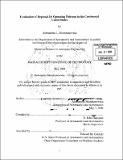Evaluation of regional jet operating patterns in the Continental United States
Author(s)
Mozdzanowska, Aleksandra L. (Aleksandra Ludmila), 1979-
DownloadFull printable version (12.65Mb)
Other Contributors
Massachusetts Institute of Technology. Dept. of Aeronautics and Astronautics.
Advisor
R. John Hansman.
Terms of use
Metadata
Show full item recordAbstract
Airlines are increasingly using regional jets to better match aircraft size to high value, but limited demand markets. The increase in regional jet usage represents a significant change from traditional air traffic patterns. To investigate the possible impacts of this change on the air traffic management and control systems, this study analyzed the emerging flight patterns and performance of regional jets compared to traditional jets and turboprops. This study used ASDI data, which consists of actual flight track data, to analyze flights between January 1998 and January 2003. In addition, a study of regional jet economics, using Form 41 data, was conducted in order to better understand the observed patterns. It was found that in 1998 US regional jet patterns and utilization closely resembled those of the turboprops. Both aircraft were used for hub feeder operations. They flew relatively short distances, under 500 nautical miles, and exhibited similar cruise altitudes and speeds. These patterns began to change as the number of regional jets increased. By January 2003, the regional jets were no longer used solely for hub feeder operations, but were flying longer routes at higher altitudes and faster speeds than turboprops. As a result, regional jets have come to fill a gap in the market by flying on longer routes than the turboprops, but shorter than the narrow body jets. An economic analysis was conducted in order to better understand the observed regional jet patterns. It was found that regional jets have lower operating costs per trip and higher operating costs per ASM than traditional jets. As a result, regional jets are currently a lower cost alternative for traditional airlines because they cover the cost of regional jet flights (cont.) on a per departure basis. However, if this structure were to change regional jets would become a less appealing alternative. To better understand the consequences of a change in the operation patterns, changes in the cost of regional and traditional jets were analyzed when trip length and pilot costs per block hour were normalized. It was found that regional jet costs per trip are very similar to traditional jet costs per trip when the trip length between the two aircraft categories is normalized, but that the normalization of pilot cost per block does not have a significant effect on the relative costs of the two aircraft types. In 2003, the US regional jet operations showed a high density of flights in the northeastern part of the country. This part of the US also has the largest concentration of traditional jet operations; this interaction may result in congestion problems since the two types of aircraft exhibit different performance. In particular, regional jets were observed to exhibit lower climb rates than traditional jets, which may impact air traffic control handling and sector design. It was also observed that as regional jets replace turboprops, they compete for runways and take off trajectories with narrow body jets. The combination of the different performance and the competition for resources between regional and other jets may result in increased delays and congestions as well as increased controller workload.
Description
Thesis (S.M.)--Massachusetts Institute of Technology, Dept. of Aeronautics and Astronautics, June 2004. "May 2004." Includes bibliographical references (p. 78-79).
Date issued
2004Department
Massachusetts Institute of Technology. Department of Aeronautics and AstronauticsPublisher
Massachusetts Institute of Technology
Keywords
Aeronautics and Astronautics.